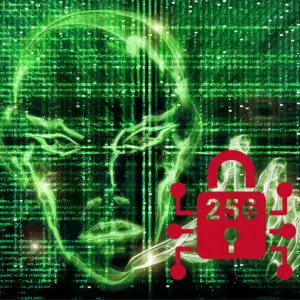QuSmart.AI Insights
The Fatal Flaw of Short Keys: Why Modern Cryptography Needs a Radical Shift
With QuSmart.AI’s Perfect Secrecy solutions, businesses can create a quantum secure system to protect data.

Tracy Levine, QuSmart.AI Co-Founder, CEO/CAIO
As computing technologies rapidly evolve—especially with advancements in artificial intelligence (AI), supercomputing, and quantum computing—traditional cryptographic techniques are increasingly at risk. The reliance on short cryptographic keys and reactive measures like Post-Quantum Cryptography (PQC) is proving insufficient for long-term security. Companies like QuSmart.AI are leading the charge in addressing this challenge by developing advanced Perfect Secrecy solutions, which offer unbreakable encryption methods designed to withstand the test of time. This article explains why a shift toward more proactive, information-theoretic security methods, such as QuSmart.AI Infinity Perfect Secrecy products and solutions, is essential to maintaining robust security in the digital age.
Introduction
The rapid pace of computational advancements has created new and profound threats to cryptography. While current cryptographic systems are designed to be resilient against contemporary threats, they are reactive by nature. This reactive approach, which includes short key lengths and PQC, may not provide lasting security. To ensure the protection of sensitive information in the face of these advancements, we need a fundamental shift toward information-theoretic security methods, such as perfect secrecy, where the key is as long as the message.
The Flaws in Reactive Cryptography
Post-Quantum Cryptography: A Temporary Fix
Post-Quantum Cryptography (PQC) is often promoted as a solution to the threat posed by quantum computing, but it has significant limitations:
- Reactionary Development: PQC is designed as a response to quantum threats, rather than a proactive rethinking of cryptographic security.
- Short-Term Thinking: While it aims to make encryption “quantum-resistant,” PQC remains vulnerable to other advancements in computational power.
- Reliance on Computational Assumptions: PQC, like its predecessors, depends on the hardness of certain mathematical problems. If these problems are solved more efficiently in the future, PQC will also become vulnerable.
The Cycle of Catch-Up
The development of PQC is part of a recurring pattern in cryptography:
- New Threat Emerges: Computational advancements create new vulnerabilities in existing cryptographic systems.
- Hasty Development: Cryptographers rush to create algorithms that resist these new threats.
- Premature Implementation: These solutions are quickly adopted, sometimes without sufficient scrutiny.
- Cycle Repeats: As new threats or weaknesses are discovered, the process starts over.
This reactive approach leaves cryptography in a constant state of catch-up, always trailing behind the capabilities of adversaries.
The Inadequacy of Short Keys
One of the major weaknesses in modern cryptography is the use of short keys, which are vulnerable to increasingly powerful attacks as computational power grows.
- Brute-Force Vulnerability: As the processing power of supercomputers and specialized hardware increases, brute-force attacks on short keys become more feasible.
- Information Leakage: Using short keys to encrypt long messages can lead to leaks that allow attackers to deduce the key or parts of the plaintext.
- No Future-Proofing: Keys that are secure today may become easily breakable tomorrow, as advancements in computational technology are unpredictable.
The Emerging Threats from Advanced Computing
Artificial Intelligence and Machine Learning
AI and machine learning introduce novel threats to cryptography that go beyond traditional cryptanalysis:
- Adaptive Attacks: AI can refine attack methods in real time, allowing it to adapt more quickly than human defenders.
- Pattern Recognition: Advanced machine learning algorithms can identify patterns in encrypted data that could lead to breakthroughs in cryptanalysis, bypassing conventional methods.
Supercomputing and Specialized Hardware
The rise of supercomputing and specialized hardware is accelerating the obsolescence of cryptographic measures:
- Massive Parallelism: Supercomputers can perform an enormous number of computations simultaneously, drastically reducing the time required to crack encryption via brute-force methods.
- Custom Cryptanalysis Hardware: Technologies like ASICs and FPGAs, which are optimized for specific cryptographic tasks, can make short keys vulnerable by speeding up the process of breaking them.
Quantum Computing
Quantum computing poses perhaps the greatest threat to traditional cryptographic systems:
- Shor’s and Grover’s Algorithms: These quantum algorithms can break many current encryption systems. Shor’s algorithm can efficiently factor large numbers, compromising RSA and ECC, while Grover’s algorithm reduces the security of symmetric keys by effectively halving their bit-length.
- Unforeseen Quantum Advances: New quantum algorithms may emerge that could break even “quantum-resistant” cryptography.
A Paradigm Shift: Proactive Cryptography and Perfect Secrecy
Instead of relying on reactionary cryptographic methods, we need a proactive shift toward cryptographic techniques that offer provable security, independent of future computational advances.
The Power of Perfect Secrecy
Shannon’s Perfect secrecy, where the cryptographic key is as long as the message itself guarantees absolute security, if the key itself has high entropy, is as long as the message, and is never used more than once.
- Unbreakable Security: In perfect secrecy, each key is used only once and is as long as the message it encrypts, making it mathematically impossible for attackers to decipher the message without access to the key.
- Future-Proof: Because the security of an Shannon’s Perfect Secrecy sometimes referred to as One Time Pad Encryptions does not rely on computational hardness, it is immune to advancements in computational power, including quantum computing.
Shannon’s Perfect Secrecy remains the gold standard.
Conclusion
Short keys and reactive cryptographic measures are no longer sufficient in the face of rapidly advancing technologies like AI, supercomputing, and quantum computing. To protect sensitive data for the long term, we need to move beyond these stopgap solutions. The future of cryptography lies in proactive, information-theoretic security methods, like perfect secrecy, where the security is guaranteed regardless of technological advances.
The cryptographic community must embrace new approaches that prioritize long-term, unconditional security over short-term fixes. By doing so, we can build cryptographic systems that stand the test of time, no matter how advanced computing becomes. QuSmart.AI is at the forefront of this shift, offering perfect secrecy solutions that ensure data security in an ever-evolving technological landscape.

The Quantum Threat Is Closer Than You Think: Why AES-256’s Days Are Possibly Numbered and You Need to Act Now
Read More »
Navigating New AI Frontiers: LLM and GA Convergence and the Need to Shift Towards Perfect Secrecy in Cryptography
Read More »QuSmart.AI is a women-founded Quantum Security company with patent pending technology for perfect secrecy solutions that are quantum-secure AI solutions.



